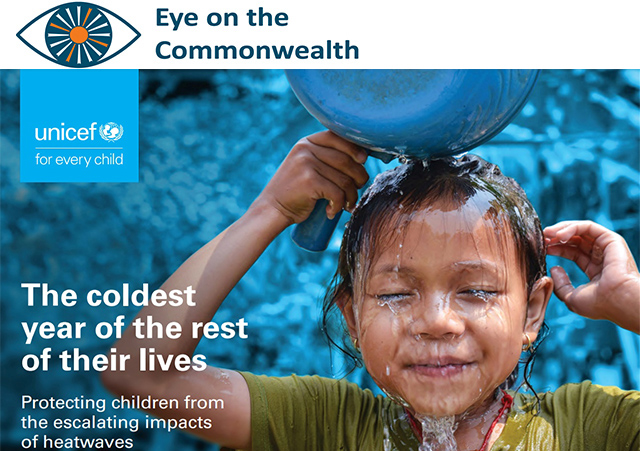 UNICEF report cover. [source: United Nations Children’s Fund, October 2022]
UNICEF report cover. [source: United Nations Children’s Fund, October 2022]
‘No children could go out to play,’ Fatima Faraz, 16, recalls of June and July this year, when schools in her hometown of Peshawar were forced to close by the latest of Pakistan’s now-routine heatwaves. ‘Many people around me got heatstroke and we couldn’t go out during the daytime.’
We all try to protect the youngest and most vulnerable members of society from danger but are we doing enough to shield them from one of the greatest threats they face? Children are on the frontline of the climate crisis, according to a new report from UNICEF, the United Nations children’s agency, which says nearly 560 million children around the world are already exposed to regular heatwaves.
The report, entitled The Coldest Year of the Rest of Their Lives, says that by 2050, under every trajectory of greenhouse gas emissions, virtually every child on the planet will face heatwaves more often, for longer and at higher temperatures. Most of the children now exposed to extreme high temperatures are in Africa and Asia, and this will also be the case in 2050.
A “just” transition to green energy: The new Commonwealth challenge
Indigenous peoples and climate change: Who pays?
Children are more vulnerable to the impact of heatwaves than adults for numerous reasons, the report explains. Young children cannot regulate their body temperature as well as adults yet spend more time outdoors for play and other activities. Extreme heat has also been linked to increases in mental health problems in children and adolescents, including post-traumatic stress disorder and depression.
There are more obvious threats to children’s health, such as increased susceptibility to asthma, and nutrition, such as reduced access to food and water due to drought and crop failure. Water shortages can force communities to rely on unsafe sources, leading to outbreaks of diseases (cholera cases are surging worldwide, for example). Extreme heat also harms children in the uterus and can lead to stillbirth, complications from gestational diabetes, and premature birth. It is also linked to under-achievement at school and lower attendance. This year the UK’s Health Security Agency increased its heat-health warning to level four for the first time, triggering the declaration of a national emergency and leading to school closures as temperatures in classrooms reached 36C.
Whether under the high or low-emission scenarios mapped out by the UNICEF report, India and Pakistan are forecast to be in the most extreme category. Fatima’s country sweltered for several months this year in temperatures of more than 40C (104F), with the unbearable heat causing casualties, power failures, fires and crop failures until the torrid weather in turn led to unprecedented monsoon rains and flooding. Some areas are expected to be under water for months to come.
The report defines high heatwave frequency as 4.5 or more heatwaves a year on average; high duration as lasting 4.7 days or longer; high severity as averaging 2C or more above the local 15-day average; and extreme high temperatures as 83.5 or more days a year exceeding 35C. According to these measures, nearly every Commonwealth country faces a potentially devastating transformation.
The Commonwealth at COP27 – timetable of events – Commonwealth Secretariat
COP27 (6-18 November) – Summit website
In Australia, for example, 270,000 children – or 5% of the population under 18 – are now exposed to frequent heatwaves. By 2050, however, even under the low-emission scenario of 1.7C of warming (which the UN has said is now all but inevitable), 99% of children are predicted to face heatwaves. Sri Lanka now has 2 million children, or 33%, facing heatwaves; by 2050, that would also be 99%. In Namibia the figure is now 660,000 (57%) but 100% by 2050. Papua New Guinea currently has only 1% of its children living through heatwaves; by 2050, it will be 99%. Very few countries break this general trend: Malta is an exception at 7% now but 6% by 2050 (the report does not explain why the often hot country should be such an outlier).
‘The children who are least responsible for climate change are bearing its biggest costs,’ according to Vanessa Nakate, the young Ugandan climate activist. So how does the world prepare for this bleak but increasingly likely predicament? UNICEF urges countries to act now in four ways: by protecting children from climate devastation by adapting social services; preparing them to live in a climate-changed world; prioritising young people in allocating climate finance and resources; and preventing climate catastrophe by slashing greenhouse-gas emissions and doing their utmost to ‘keep 1.5C alive’.
Does the political will exist for the sustained effort and mindshift necessary to effect change? This month’s COP27 climate summit in Egypt is the perfect arena to display the resolve the world’s children need. The UK presided over COP26 in Glasgow but the initial response from the new British prime minister, Rishi Sunak, was to announce that he would not be attending the conference (a decision later reversed under pressure). This blank denial of the gravity of climate change dis not bode well. As Rebecca Newsom, of Greenpeace UK, said: ‘The UN secretary-general said that countries must “re-prioritise climate change or the world faces catastrophe”. Which one would Sunak rather?’
Oren Gruenbaum is a member of the Round Table Editorial Board.
‘Eye on the Commonwealth’ columns look at current issues facing the Commonwealth



